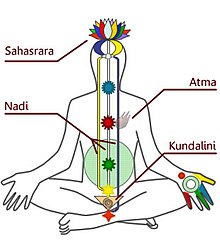Kundalini
Appearance
This article does not cite its sources. |

Kuṇḍalinī is a form of divine energy in Hindu mysticism.
Quotes on Kundalini:
[edit]- The snake, fearful for its poison, symbolizes all evil forces; in the same way the kuṇḍalinī, as long as it rests inert in us, corresponds to our unconscious energies, dark, at the same time poisoned and poisonous. Conversely, these same energies, awakened and dominated, become efficient and confer real power. (Lilian Silburn)
- The exhaled breath comes out and the inhaled breath comes in, at will. The sinuous looking one gets longer. She is the great Goddess, at once inferior and superior, the supreme Sanctuary. (Vijñānabhairava Tantra)
- The supreme discernment relating to energy (kuṇḍalinī) therefore involves thirteen stages. And in all the treatises of the Trika, Śiva himself makes allusion to it. (Somānanda)
- In this stage, the yogi loses awareness of the objective world. When the kuṇḍalinī reaches the palatine vault (tālu), he experiences a sort of drowsiness (nidrā) which Saint Teresa of Ávila called "sleep of the powers". The ordinary body, will and knowledge are numb, but the heart is awake. (Lilian Silburn)
- Kundalini is at the same time a serpent, an intimate energy and a goddess: the esotericism of the twilight language resides in this simultaneity of meanings in the same word. (Jean Varenne)
- O vision of immortal and supreme ambrosia that shines with conscious light flowing from the absolute Reality, be my refuge. Thanks to it those who know the mystical arcane (rahasya) adore you. (Abhinavagupta)
- When the sleeping Goddess is awakened by the grace of the guru, all the cakras are passed through rapidly. (Śiva Saṃhitā)
- This kalā, which is the light of all things, presents itself, when devoid of emission, in the form of serpentine-power (śakti kuṇḍalikā), therefore in the form of serpentine-vital breath, and, at the extremity (prāntadeśe) of the emission, in the form of a supreme serpentine. This kalā is variously called the "ether of Śiva", "place of the self", "place of brahman". (Triśirobhairava Tantra)
- This power is called supreme, subtle, it transcends every norm of behavior. Wrapped around the luminous point (bindu) of the heart, inside she lies sleeping, O Blessed One, in the form of a sleeping serpent and is aware of nothing, O Umā. This Goddess, after having placed the fourteen worlds into her womb together with the moon, the sun and the planets, falls into a state of obfuscation like someone who is clouded by poison. She is awakened by the supreme natural resonance of knowledge, [as she] is shaken, O Excellent One, by that bindu which lies in her womb. In fact, a shaking is produced in the body of Power with an impetuous spiral motion. From penetration, the shining points of energy arise first. Once raised It is the subtle Force (kalā), Kuṇḍalinī. (Tantrasadbhāva)
- You should stimulate that sleeping snake by grasping its tail. Then that shakti, awakening from her torpor, will be forced to rise upwards. This should be done with the paridhana technique and, by inhaling through the solar channel, one will have its awakening every day for ninety minutes, morning and evening. (Haṭhayoga Pradīpikā)
- Between the anus and the virile organ is the basic center, the Mūlādhāra, which is like a matrix, a yoni (female organ). There is the bulb-shaped 'root' and there is the fundamental energy Kuṇḍalinī wrapped three and a half times around itself. Like a snake, it surrounds the starting point of the three main arteries, holding its tail in its mouth just in front of the opening of the central artery (suṣumnā). (Śiva Saṃhitā)
Note:
[edit]



